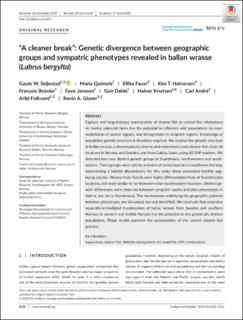| dc.contributor.author | Seljestad, Gaute | |
| dc.contributor.author | Sanchez, Maria Quintela | |
| dc.contributor.author | Faust, Ellika | |
| dc.contributor.author | Halvorsen, Kim Aleksander Tallaksen | |
| dc.contributor.author | Besnier, Francois | |
| dc.contributor.author | Jansson, Eeva | |
| dc.contributor.author | Dahle, Geir | |
| dc.contributor.author | Knutsen, Halvor | |
| dc.contributor.author | André, Carl | |
| dc.contributor.author | Folkvord, Arild | |
| dc.contributor.author | Glover, Kevin | |
| dc.date.accessioned | 2021-03-24T09:47:34Z | |
| dc.date.available | 2021-03-24T09:47:34Z | |
| dc.date.created | 2020-06-06T09:47:11Z | |
| dc.date.issued | 2020 | |
| dc.Published | Ecology and Evolution. 2020, 10 (12), 6120-6135. | |
| dc.identifier.issn | 2045-7758 | |
| dc.identifier.uri | https://hdl.handle.net/11250/2735238 | |
| dc.description.abstract | Capture and long‐distance translocation of cleaner fish to control lice infestations on marine salmonid farms has the potential to influence wild populations via overexploitation in source regions, and introgression in recipient regions. Knowledge of population genetic structure is therefore required. We studied the genetic structure of ballan wrasse, a phenotypically diverse and extensively used cleaner fish, from 18 locations in Norway and Sweden, and from Galicia, Spain, using 82 SNP markers. We detected two very distinct genetic groups in Scandinavia, northwestern and southeastern. These groups were split by a stretch of sandy beaches in southwest Norway, representing a habitat discontinuity for this rocky shore associated benthic egg‐laying species. Wrasse from Galicia were highly differentiated from all Scandinavian locations, but more similar to northwestern than southeastern locations. Distinct genetic differences were observed between sympatric spotty and plain phenotypes in Galicia, but not in Scandinavia. The mechanisms underlying the geographic patterns between phenotypes are discussed, but not identified. We conclude that extensive aquaculture‐mediated translocation of ballan wrasse from Sweden and southern Norway to western and middle Norway has the potential to mix genetically distinct populations. These results question the sustainability of the current cleaner fish practice. | en_US |
| dc.language.iso | eng | en_US |
| dc.publisher | Wiley | en_US |
| dc.rights | Navngivelse 4.0 Internasjonal | * |
| dc.rights.uri | http://creativecommons.org/licenses/by/4.0/deed.no | * |
| dc.title | “A cleaner break”: Genetic divergence between geographic groups and sympatric phenotypes revealed in ballan wrasse (Labrus bergylta) | en_US |
| dc.type | Journal article | en_US |
| dc.type | Peer reviewed | en_US |
| dc.description.version | publishedVersion | en_US |
| dc.rights.holder | Copyright 2020 The Authors. | en_US |
| cristin.ispublished | true | |
| cristin.fulltext | original | |
| cristin.qualitycode | 1 | |
| dc.identifier.doi | 10.1002/ece3.6404 | |
| dc.identifier.cristin | 1814154 | |
| dc.source.journal | Ecology and Evolution | en_US |
| dc.source.40 | 10 | |
| dc.source.14 | 12 | |
| dc.source.pagenumber | 6120-6135 | en_US |
| dc.subject.nsi | VDP::Genetikk og genomikk: 474 | en_US |
| dc.subject.nsi | VDP::Genetics and genomics: 474 | en_US |
| dc.subject.nsi | VDP::Genetikk og genomikk: 474 | en_US |
| dc.subject.nsi | VDP::Genetics and genomics: 474 | en_US |
| dc.identifier.citation | Ecology and Evolution. 2020, 10 (12), 6120-6135. | en_US |
| dc.source.volume | 10 | en_US |
| dc.source.issue | 12 | en_US |

